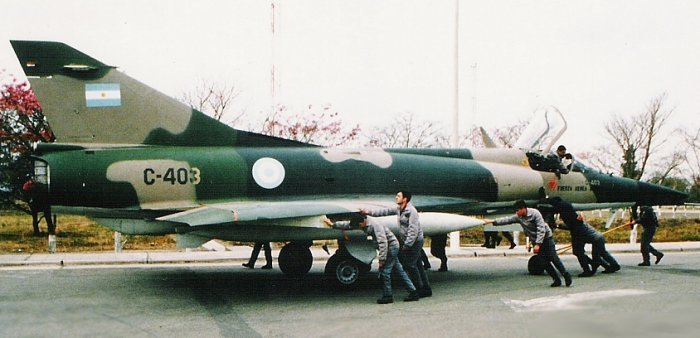- IAI Nesher
Infobox Aircraft
name = Nesher
caption =Argentine Air Force Dagger,Jujuy Airport, 1981
type = Multi-role fighter aircraft
manufacturer = IAI
first flight =1971
introduced =1972
retired = 1977 (Israel)
number built =61 (51+10)
status =Active service
primary user =Israeli Air Force
more users =Argentine Air Force
developed from =Dassault Mirage 5
variants with their own articles =The
Israel Aircraft Industries Nesher (Vulture in Hebrew) is theIsrael i name of theDassault Mirage 5 multi-role fighter aircraft. Most were later sold to theArgentine Air Force as Daggers, and later upgraded as Fingers.Design and development
Dassault Aviation had developed the Mirage 5 at the request of the Israelis, who were the main foreign customers of the Mirage III. TheIsraeli Air Force (IAF) wanted the next version to have less all-weather capability in exchange for improved ordnance carrying capacity and range as the weather in the Middle East is mostly clear.The French government arms embargo on Israel (on the eve of the
Six Day War and afterwards) prevented the first 30 Mirage 5 aircraft (which were already paid for by Israel) plus optional 20 from being delivered and cut off support for the existing Mirage IIICJ fleet. Officially, Israel built the aircraft after obtaining complete blueprints. However, some sources claim Israel received 50 Mirage 5s in crates fromFrench Air Force (AdA), while the AdA took over the 50 aircraft originally intended for Israel. [ [http://www.acig.org/artman/publish/article_263.shtml Wing Magazine, Vol. 30/No 4, August 2000, p.48, Swiss Federal Court] ] [ [http://www.acig.org/artman/publish/article_274.shtml Wing Magazine, Vol. 30/No 4, August 2000, p.48, Swiss Federal Court] ]The Nesher was identical to the Mirage 5, except for the use of some Israeli
avionics , aMartin-Baker zero-zero ejector seat , and provisions for a wider range of AAMs (Air-to-Air Missiles), including the IsraeliShafrir heat-seeking missile . Fifty-one Nesher fighters (Nesher S) and ten Nesher two-seat trainers (Nesher T) were built in all.Nesher production was phased out from 1978 to make way for an improved Mirage derivative that had been in planned in parallel, in which the Atar engine was replaced by an Israeli-built
General Electric J79 engine, the engine used on the AmericanF-104 Starfighter andF-4 Phantom II fighters. The result was theIAI Kfir .Finger
In the 1979 contract with IAI, the
Argentine Air Force stipulated that the "Daggers" would be equipped with new avionics and HUD systems to take them to the Kfir C.2 (and beyond in some subsystems) standard. The program, named "Finger", was underway in 1982 when the war broke out. With the war over, as some of these systems were made by the BritishMarconi Electronic Systems , they needed to be replaced after an arms embargo was imposed by theUK . The replacement of such systems took the planes to the final "Finger IIIB" standard mainly by replacing the British equipment with French-builtThomson-CSF . ["Dagger & Finger en Argentina" ISBN 987-43-8536-7 [http://www.helis.com/magazines/books.php book link] ]Operational history
The first Nesher prototype flew in September 1969, with production deliveries to the IAF beginning in May 1971, ending in February 1974. These aircraft performed well during the
1973 Yom Kippur War , claiming over a hundred kills. An estimated 15 Neshers were lost in combat or otherwise. [ [http://www.acig.org/artman/publish/article_274.shtml] ]Survivors of these aircraft were refurbished and exported to
Argentina in two batches, 26 in 1978 and 13 in 1980, under the name "Dagger", comprising 35 "Dagger A" single-seat fighters and 4 "Dagger B" two-seat trainers.They form a new unit, 6th Air Group, and they were immediately listed with the help of the 8th Air Group (Mirage IIIEA) and the
Peruvian Air Force , already a user of the Mirage 5, due the escalating crisis withChile of that year.During the 1982
Falklands War , they were deployed to the southern naval airbase ofRío Grande, Tierra del Fuego , and an airfield inPuerto San Julián and despite the distance to their targets and lack ofaerial refueling capability, managed to make 153 sorties against both ground and naval targets on the 45 days of operations. In the last role they damagedHMS Antrim (D18) ,HMS Brilliant (F90) ,HMS Broadsword (F88) ,HMS Ardent (F184) ,HMS Arrow (F173) andHMS Plymouth (F126) . [ [http://www.naval-history.net/F62brshipslost.htm British Ships Lost & Damaged] ] Eleven Daggers were lost in combat (nine by AIM-9L Sidewinders fired from Sea Harriers and two by Surface to Air Missiles). [Draper et al 1986, page 129,130]Variants
* Nesher S : Single-seat ground-attack fighter version for the Israeli Air Force.
* Nesher T : Two-seat training version for the Israeli Air Force.
* Dagger A : Refurbished single-seat fighter version for the Argentine Air Force.
* Dagger B : Refurbished two-seat training version for the Argentine Air Force.
* Finger I :
* Finger II :
* Finger III :Operators
;ARG
*Argentine Air Force ;ISR
*Israeli Air Force pecifications
ee also
aircontent
related=
*Dassault Mirage 5
*IAI Kfir
similar aircraft=
lists=
see also= max speed: 2350 km/hservice celling 59,473 feet armament: 2 DEFA 30 mm cannons on lower fuselage and 9620 lb (4200) kg of bombs,rockets and missiles on6 underwing and one centerline stores pylonsReferences
Bibliography
*cite book |last= Burden|first= Rodney |authorlink= |coauthors= Michael Draper, Douglas Rough, Colin R Smith, David L Wilton|title= Falklands the Air War|year= 1986|publisher= Arms and Armour Press|location= London |isbn= 0-85368-842-7|pages=
Further Reading
* [http://www.acig.org/artman/publish/article_263.shtml War of Attrition, 1969-1970] , ACIG, retrieved October 13, 2006
* [http://www.acig.org/artman/publish/article_274.shtml Dassault Mirage 5/Nesher in Service with the IDF/AF] , ACIG, retrieved October 13, 2006
* "The Designer of the B-1 Bomber's Airframe", Wing Magazine, Vol. 30/No 4, August 2000, p.48
* Swiss Federal Court, case of Alfred Frauenknecht, appeal verdict, November 3, 1970.
* cite book
last=Breffort
first=Dominique
coauthors=Jouineau, Andre
year=2004
publisher=Histoire et Collections, Paris
title=The Mirage III, 5, 50 and derivatives from 1955 to 2000
series=Planes and Pilots 6
isbn=2-913903-92-4
* cite book
last=Pérez San Emeterio
first=Carlos
year=1978
publisher=Editorial San Martin, Madrid
language=spanish
title=Mirage. Espejismo de la técnica y de la política
series=Armas 30
isbn=8471401584External links
* [http://www.mirageargentina.com.ar/ Mirage Argentina, el sitio de los Deltas argentinos] "(in spanish)"
Wikimedia Foundation. 2010.
